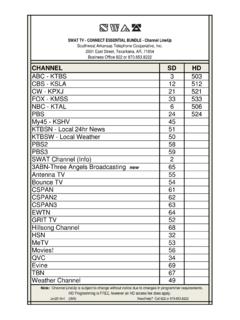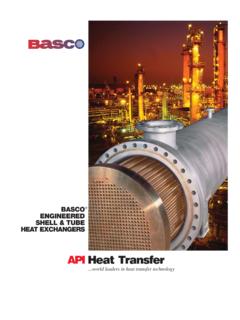Transcription of UMDNS GMDN - WHO
1 Copyright ECRI Institute 2011 (not including the gmdn code and device name). Reproduced with Permission from ECRI Institute s Healthcare Product Comparison System. Copyright gmdn Agency 2011. gmdn codes and device names are reproduced with permission from the gmdn medical equipment - InformationHealth problem addressedColonoscopes are used for the removal of foreign bodies, excision of tumors or colorectal polyps (polypectomy), and control of hemorrhage. Routine colonoscopy is important in diagnosing intestinal cancer, the second leading cause of cancer deaths in the United States.
2 These endoscopic procedures reduce the need for invasive surgical diagnostic and therapeutic descriptionThese devices consist of a proximal housing, a fl exible insertion tube, and an umbilical cord connecting the light source and the proximal housing. The proximal housing, which is designed to be held in one hand, typically includes the eyepiece (fi beroptic models only), controls for distal tip (bending section) angulation and suction, and the working channel port. Colonoscopes have several hollow channels for suction, water and air delivery, and insertion of accessory instruments and cannulae.
3 The distal tip of video colonoscopes includes a charge-coupled device (CCD) that serves as a small camera and electronically transmits the image from the CCD to an external video-processing of operationVideo colonoscope insertion tubes contains a fi beroptic light bundle, which transmits light from the light source to the tip of the endoscope. Each fi beroptic bundle consists of thousands of individual glass fi bers coated with glass causing internal refl ections that allow light transmission through the fi ber even when it is fl exed.
4 The light is used to illuminate the fi eld of view in the patient s colon. Video images are detected by the CCD and are then transmitted to the video processor and then display monitors or recording stepsThe patient typically lies on his or her side on a procedure table. Patients typically will require anesthesia or conscious sedation before insertion of the colonoscope. The colonoscope is inserted into the colon via the rectum by a gastroenterologist. Video images are typically viewed throughout the procedure on a video monitor.
5 These images can then be recorded, printed, stored on digital media, or transmitted to another location for simultaneous viewing. The gastroenterologist manipulates the direction of the device using controls on the colonoscope control problemsAlthough rare, trauma to the colon and adjacent organs during colonoscopy can result in complications such as bleeding, peritonitis, and appendicitis. ECRI Institute has received reports of diffi culty in inserting forceps through the instrument channel of contorted colonoscopes, causing delays in procedures.
6 Problems have occurred related to blockage of the air channel from inadequately rinsed disinfectant or retrograde fl ow of protein material into the channel during a procedure. Also, patient infection is a common mainly from improper cleaning and disinfection and maintenanceUser(s): GastroenterologistMaintenance: Medical staff; technician; biomedical or clinical engineer; central sterile processing technician for cleaning and disinfectingTraining: Supervised training with experienced usersEnvironment of useSettings of use: Gastroenterology lab or suite, operating roomRequirements: Stable power source; access to anesthesia and patient monitoring.
7 Oxygen and suction should be available; endoscopy suite should have direct external ventilation, HEPA fi ltrationProduct specifi cationsApprox. dimensions (mm): 1,700 Approx. weight (kg): 5 Consumables: NAPrice range (USD): 25,000 - 41,000 Typical product life time (years): 4 - 5 Shelf life (consumables): NATypes and variationsVideo; fi beropticColonoscopeUMDNSGMDN10950 Colonoscopes36117 Flexible video colonoscopeOther common names: Endoscopes; video endoscopes; Video colonoscope, fl exible; Video colonosco
















